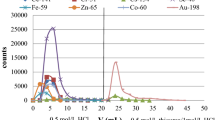Summary
Mercury is determined by instrumental neutron activation analysis and Ge(Li) gamma-ray spectroscopy in biological and environmental samples. Samples are sealed in polyethylene vials and irradiated with standards for 8–10 hours in a water cooled assembly at a thermal neutron flux of 8.1012 neutrons/cm2/second. High resolution gamma-ray spectroscopy allows the measurement of the 279 keV gamma ray of203Hg. Corrections are made for203Hg decay and for75Se interference on the 279 keV gamma-ray. No interferences are important in biological or environmental samples and the problem of mercury volatilization and loss is eliminated by cooling during irradiation and the use of a sealed irradiation/counting container. The precision (counting statistics) of a single determination range from 0.4 to 15% (relative standard deviation). The detection limit for mercury varies with sample composition. For human blood the detection limit is 0.0035 ppm Hg.
Zusammenfassung
Quecksilber wird im Wege der Neutronenaktivierungsanalyse und der Ge(Li)-Gammaspektroskopie in biologischem Material und in Milieuproben bestimmt. Die Proben werden in Polyäthylenröhrchen eingeschmolzen und zugleich mit Standardproben 8 bis 10 Stunden unter Wasserkühlung mit einem thermischen Neutronenfluß von 8 · 1012 Neutronen/cm2/sek bestrahlt. Gammaspektroskopie mit hoher Auflösung gestattet die Messung der 279-keV-Strahlung des203Hg. Korrekturen für den Verlust an203Hg und für die Störung durch75Se sind erforderlich. In biologischem Material und in Milieuproben treten bedeutende Störungen nicht auf. Dem Problem der Hg-Verflüchtigung wird durch Kühlung während der Bestrahlung und durch einen verschmolzenen Bestrahlungsbehälter begegnet. Die Genauigkeit (Zählungstatistik) einer Einzelbestiramung beträgt 0,4 bis 15% (rel. Standardabweichung). Die Erfassungsgrenze für Hg hängt von der Zusammensetzung der Probe ab. Sie beträgt für menschliches Blut 0,0035 ppm Hg.
Similar content being viewed by others
References
J. F. Coetzee in “Treatise in Analytical Chemistry”, Part II, Vol.3,I. M. Kolthoff, P. J. Elving andE. B. Sandell, Eds. New York: Interscience. 1961. p. 231.
H. L. Kahn in “Trace Inorganic in Water”,R. A. Baker. Ed., Ch. 11. American Chemical Society Advances in Chemistry Series No. 73.
N. W. H. Addink in “Trace Characterization”,W. W. Meinke andB. F. Sribner, Eds. p. 163. Natl. Bur. Stds. Monograph 100, 1967.
D. Brune, Acta Chim. Scand.20, 1200 (1966).
D. Brune andO. Landstrom, Radiochim. Acta5, 228 (1966).
R. H. Filby, A. I. Davis, G. G. Wainscott, W. A. Haller, andW. A. Cassatt, “Gamma-Ray Energy Tables for Neutron Activation Analysis”. Washington State University Report WSU-NRC-97, 1969.
L. Kosta andA. R. Byrne, Talanta16, 1297 (1969).
I. Hadzistelios andA. P. Grimanis in “Modern Trends in Activation Analysis”, Natl. Bur. of Standards, Special Publication 312, Vol. 1. Washington, D. C. 1969. p. 184.
L. A. Rancitelli, J. A. Cooper, andR. W. Perkins in “Modern Trends in Activation Analysis”, Natl. Bureau of Standards, Special Publication 312, Vol. 1. Washington, D.C. 1969. p. 101.
W. A. Haller, R. H. Filby, L. A. Rancitelli, andJ. R. Cooper in “Modern Trends in Activation Analysis”, Natl. Bur. of Standards, Special Publication 312, Vol. 1. Washington, D. C. 1969. p. 177.
H. J. M. Bowen, Analyst92, 124 (1967).
H. J. M. Bowen in “Advances in Activation Analysis”, Vol. 1,J. M. A. Lenihan andS. J. Thomson, Eds. New York: Academic Press. 1969. p. 108.
R. A. Nadkarni andW. D. Ehman, J. Radioanal. Chem.3, 175 (1969).
R. S. Rochlin, Nucleonics17, 54 (1959).
H. J. M. Bowen andP. A. Cawse, U. K. Atomic Energy Authority Report, AERE-R 4309, 1963.
W. A. Haller, R. H. Filby, andL. A. Rancitelli, Nuclear Appl.6, 365 (1969).
H. D. Livingstone, H. Smith, andN. Stojamovic, Talanta14, 505 (1967).
Author information
Authors and Affiliations
Rights and permissions
About this article
Cite this article
Filby, R.H., Davis, A.I., Shah, K.R. et al. Determination of mercury in biological and environmental materials by instrumental neutron activation analysis. Mikrochim Acta 58, 1130–1136 (1970). https://doi.org/10.1007/BF01215948
Received:
Issue Date:
DOI: https://doi.org/10.1007/BF01215948




